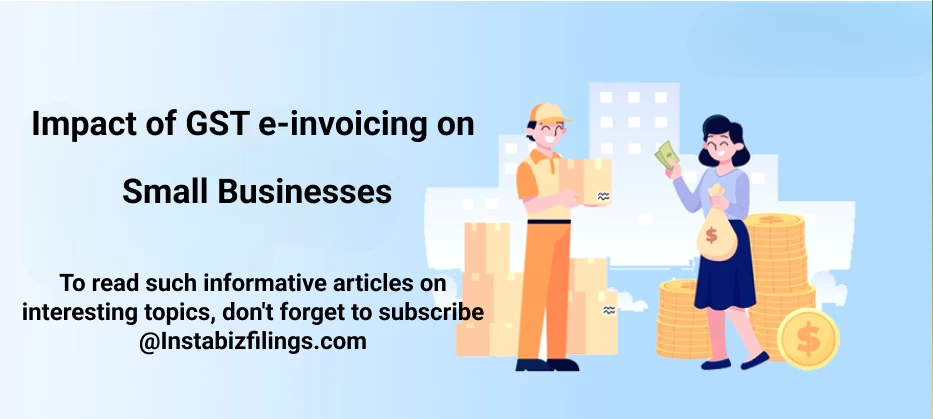
Impact of GST e-invoicing on small businesses
November 26, 2025 by Team Instabizfilings
What Is GST E-Invoicing?
-
Definition: Under GST, e-invoicing refers to the fact that B2B invoices (and some other documents) are created in a standard digital format, submitted to an Invoice Registration Portal (IRP) managed by the government, verified and assigned a unique Invoice Reference Number (IRN) and a QR code.
-
Phased Implementation: The system has been rolled out gradually. First, e-invoice was only required by very large taxpayers; it has since been reduced.
-
Current Threshold: According to the latest change, businesses that have an aggregate turnover of 5 crore or higher in any of the previous financial years (since FY 2017-18) must use e-invoicing (in the B2B-case).
-
Time Limits: The invoices (together with their notes such as credit card/debit) should be reported within 30 days of the date of issue.
Why the Government Is Pushing E-Invoicing (Policy Rationale)
-
Curbing Fraud: Real-time invoice checking prevents the fake invoices and false input tax credit (ITC) claims.
-
Transparency & Data Accuracy: Since invoices are designed and approved, the possibilities of data inconsistency during returns diminish.
-
Efficiency in GST Compliance: E-invoicing helps auto-populate invoice data into GST returns (like GSTR-1) and e-way bills, reducing manual entry.
-
Better Cash Flow for Suppliers: The existence of IRN-verified invoices in small suppliers not only establishes them as credible but also has the potential to speed up the payment process and facilitate their access to formal credit/invoice financing.
Impact on Small Businesses (Pros & Cons)
Benefits / Opportunities
-
Improved Cash Flow
- E-invoices are digitally verified and thus customers can trust them and be able to make faster payments.
- Improved access to invoice funding: Financial institutions find it easier to evaluate and fund on proven invoice information.
-
Reduced Errors & Reconciliation Burden
- Information is organized; it minimizes human mistakes.
- Automated reconciliation: e-invoice data is submitted into GST returns (GSTR-1) and also in e-way bills which minimizes repetition.
-
Stronger Compliance and Credibility
- Small businesses that send e-invoices are viewed as being more "compliant" and that this may enhance their reputation among large buyers.
- Audits are made easier by standardized formats and computerized records.
-
Better Input Tax Credit (ITC) Flow
- ITC can be claimed with greater confidence by its recipients since invoices are validated.
- Reduces discrepancies in claims of credit, and this benefits buyers and suppliers within the supply chain.
-
Long-Term Digital Transformation
- The adoption of e-invoicing compels small firms to modernize their accounting / ERP systems to aid digitization.
- Once a digital backbone is in place, it's easier to scale operations, integrate other tools, and adopt more automation.
Challenges / Risks
-
Technology & Infrastructure Costs
- Some of the small businesses do not have well-developed accounting or billing systems; therefore, they would need upgrades to their systems or purchasing new ones to hook up with IRP.
- Connection to the internet: To execute real-time validation, one needs the internet to be stable; in smaller towns and the villages, it might be an issue.
- Training: The staff has to be trained to operate with a new system; the accuracy of the data is of utmost importance (incorrect GSTIN, HSN codes, etc., may result in denials).
-
Compliance Burden
- The pressure is exerted by the necessity to report invoices to IRP within a limited period of time (30 days).
- Strict validation: Data can be rejected by IRP in case of wrong data, which leads to delays. Penalties: A non-IRN audit can result in financial fines and creating non-IRN invoice.
-
Cash Flow Risk (if not managed well)
- In case of invoice rejection or failure to generate the invoices appropriately, the small suppliers will experience delays in payments, which may be a strain on working capital.
- Non-IRN invoices might be rejected by the buyers, which will influence business relations or even the right to claim ITC.
-
Transition Costs & Change Management
- The cultural change to e-invoicing may be dramatic to businesses that are accustomed to manual (or semi-manual) invoicing.
- Small businesses (owner-managed) might not be open to new technology.
- Third-party software provider reliance: It can be a problem of reliability, compatibility and cost.
-
Technical Reliability and System Downtime
- Invoice generated may be disrupted by IRP downtime or glitches.
- The rejections may occur due to mistakes in data payload (JSON) or schema mismatch.
Strategic Preparation: How Small Businesses Can Get Ready
Here are actionable steps and best practices for small businesses to prepare for e-invoicing:
-
Assess Readiness
- Check if your turnover in past years surpasses the e-invoice threshold (₹ 5 crore currently).
- Assess existing accounting / ERP system: Does it have an ability to create invoices in the necessary format of JSON?
- Carry out gap analysis: What are your technical, process and manpower gaps that you need to fill?
-
Choose the Right Technology Partner
- Search on e-invoicing packages or services providers to support the integration of IRP.
- Prefer solutions that offer automated IRN generation, QR code embedding, error checking, and GST return auto-population.
- Consider cloud-based (SaaS) tools to reduce upfront infrastructure costs.
-
Build Internal Competence
- Train your finance & accounting team on e-invoice rules, data fields (GSTIN, HSN/SAC, etc.), IRP workflows.
- Establish SOPs (Standard Operating Procedures) about how to create invoices, validate invoices, correct invoice errors and re-file invoices.
- Set up a review/checklist process: before uploading invoices to IRP, verify critical fields.
-
Implement Change Management
- Inform customers (particularly B2B partners) regarding the move towards e-invoicing.
- Re-negotiate terms where necessary: such as making sure your customers only accept invoices in IRN, or how to deal with non-payment.
- Then encourage or support your supply chain (vendors) to also transition to e-invoicing as well- support down the line.
-
Ensure Operational Resilience
- Keep a buffer time: Since there is no guarantee that IRP integration will be smooth at all times at the beginning, make contingencies.
- Backup systems: Keep fallback options (like manual invoices) for emergencies or rejections.
- Report on the performance of the monitor system: Measure IRP response time, rejections, errors and improve your process.
-
Financial Planning
- Estimate start up expenses: software, training, potential consultant assistance.
- Take into consideration cash flow implications: make sure that you will be able to handle the situation in case some invoices are not accepted and that they should be corrected.
- Finance: Invite bids: Invite bids to use invoice financing with verified e-invoices to control working capital.
-
Compliance & Audit Readiness
- Establish timely in-house audits of e-invoice information.
- Maintain documentation of IRN generation, submissions, rejections, corrections.
- Keep pace with the changes in regulation: E-invoicing regulations and GST regulations change, so assign someone (or hire a consultant) to monitor change.
-
Leverage Government / Industry Support
- Refer to government instructions, webinars, helplines to clear up the questions.
- Join MSME forums or tax practitioner groups to share experiences and solutions.
- Search incentivized programs (where any exist) which aid in the digital adoption.
Long-Term Implications for Small Businesses
-
Greater Formalization: More and more small firms issue e-invoices, which makes them a part of a more formal and traceable supply chain that can make them more credible and available to bigger customers.
-
Lower Risk of Fraud: Minimized Fraud helps in reducing compliance Risk as well as financial loss in the long term through real-time validation.
-
Digital Maturity: The shift could speed up digital transformation of MSMEs by making them embrace ERP, automate AP/AR processes, and use analytics.
-
Access to Finance: Verified invoice data enhances trust with financial institutions; this could make invoice financing, working capital loans, or credit lines more accessible.
-
Operational Efficiency: Over time, reduced manual work in GST returns, fewer disputes, and smoother reconciliations can free up resources for growth.
Risks to Watch & Mitigations
Here are some key risks for small businesses and how to mitigate them:
|
Risk |
Mitigation |
|
Invoice Rejection by IRP |
Validate data before submission, keep error-handling SOPs, and monitor rejection reasons. |
|
Cash Flow Disruption |
Build a buffer, correct rejected invoices quickly, and ensure clients understand e-invoice importance. |
|
High Tech Cost |
Use cloud/SaaS-based e-invoicing tools, negotiate with vendors, or explore shared services. |
|
System Downtime |
Maintain alternative invoicing processes, schedule critical uploads in low-traffic times, monitor IRP status. |
|
Non-Acceptance by Customers |
Communicate early, educate customers, and possibly include e-invoice clauses in contracts. |
Conclusion
-
Short-Term Pain, Long-Term Gain: Yes, it is likely that the upfront costs, tech integration, training, and process change will also be involved, particularly with small businesses. However, this can pay-off when it comes to efficiency, credibility, and improved financial management.
-
Competitive Advantage: Small businesses which embrace the use of e-invoicing early and effectively may have a reputation advantage with bigger clients and may alleviate their GST compliance load.
-
Policy Alignment: Since the government is driving e-invoicing as a way to seal tax leakages, small businesses that comply with such standards are unlikely to be exposed to compliance risk, and might also enjoy facilitated ICT flows.
-
Scalability: When the system has been established it can support the expansion of the business as the business expands, invoicing, finance, and audit services are better supported.
Disclaimer
The information provided in this blog is purely for general informational purposes only. While every effort has been made to ensure the accuracy, reliability and completeness of the content presented, we make no representations or warranties of any kind, express or implied, for the same.
We expressly disclaim any and all liability for any loss, damage or injury arising from or in connection with the use of or reliance on this information. This includes, but is not limited to, any direct, indirect, incidental, consequential or punitive damage.
Further, we reserve the right to make changes to the content at any time without prior notice. For specific advice tailored to your situation, we request you to get in touch with us.


